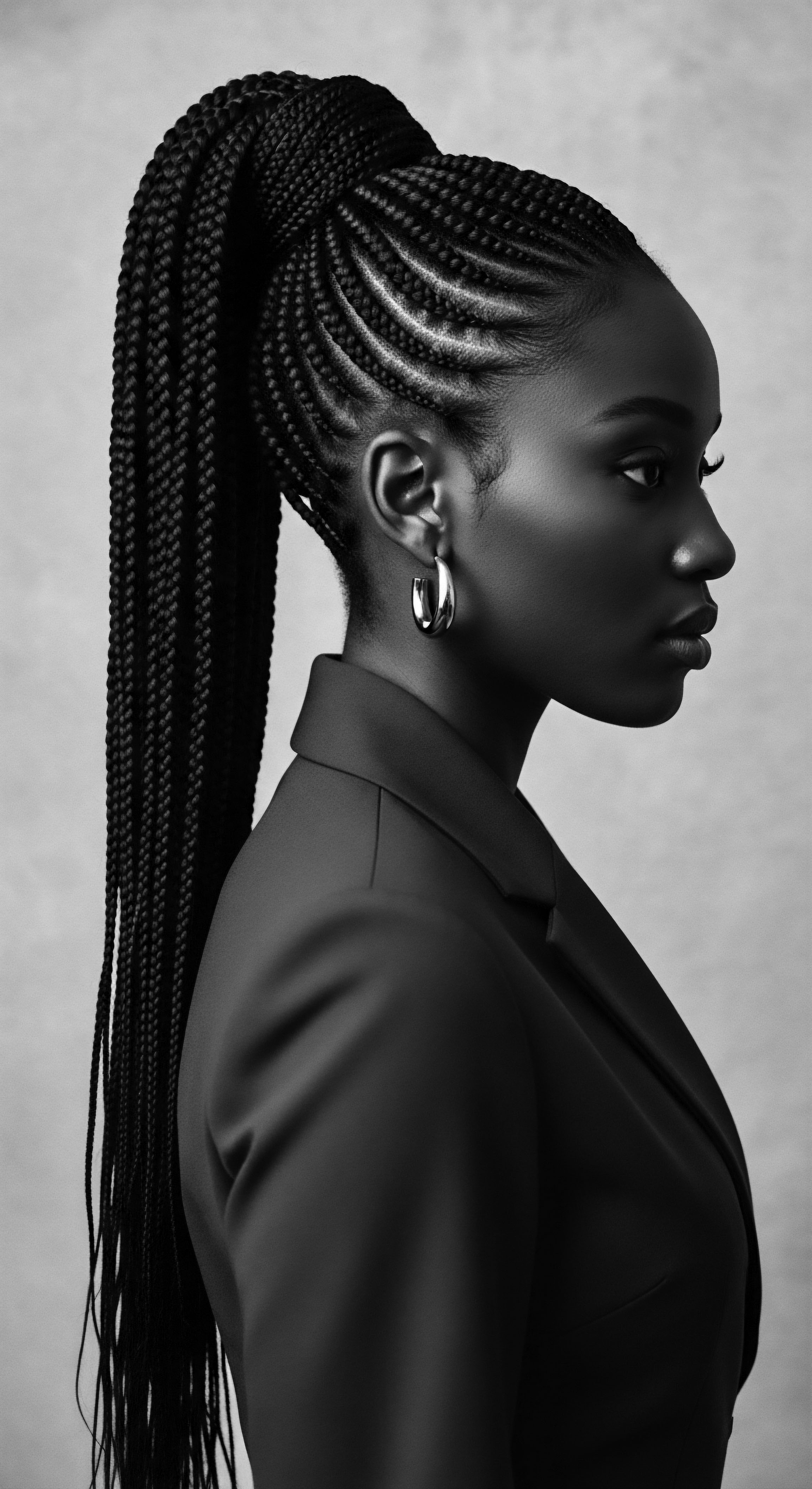
Fundamentals
The very notion of “Henna Ancient Egypt” summons forth images of sun-drenched landscapes and timeless beauty rituals, practices that held profound significance for the people along the Nile. At its simplest, henna, derived from the plant Lawsonia inermis, represents a natural dye. This botanical marvel, native to the warmer climes of North Africa, the Middle East, and parts of Asia, yielded a reddish pigment when its dried and crushed leaves were mixed with water.
For the ancient Egyptians, its utility extended far beyond mere cosmetic adornment. It was a substance woven into the very fabric of their daily lives, their spiritual beliefs, and their preparations for the afterlife.
The application of henna served a multitude of purposes in this venerable civilization. It colored fingernails and toenails, offering a vibrant accent to the hands and feet. More notably, it was used to tint hair, imparting a reddish-brown hue.
This coloring was not simply about aesthetic preference; it often carried deeper connotations. Beyond its visual appeal, henna also possessed practical and medicinal qualities, valued for its cooling properties in the scorching desert climate and its antimicrobial attributes.
Archaeological discoveries provide tangible evidence of henna’s deep roots in ancient Egyptian society. Mummified remains, some dating back to the predynastic period around 3400 BCE, reveal hair and even fingertips stained with what is believed to be henna. Such findings suggest its role in funerary practices, perhaps to restore a youthful appearance to the deceased or as part of a ritual to preserve the body and spirit. The enduring presence of henna across millennia underscores its fundamental importance in the ancient Egyptian understanding of beauty, wellness, and the journey beyond life.

The Plant’s Elemental Gifts
The Lawsonia Inermis shrub, the botanical source of henna, yields its potent dye from its leaves. These leaves contain a molecule known as lawsone, which, upon contact with proteins like those found in hair, skin, and nails, creates a bond that results in a reddish-orange stain. The intensity and depth of this color were influenced by factors such as the plant’s growing environment and its stage of life, as noted even in ancient Egyptian records like the Ebers Papyrus. This inherent biological property of the plant was harnessed with remarkable ingenuity by the Egyptians.
From a heritage perspective, the understanding of this plant’s elemental biology speaks to an ancestral wisdom that deeply appreciated nature’s offerings. It was not merely about a surface-level application; there was an intuitive grasp of how the plant interacted with the human body, leading to its widespread and diverse applications. This foundational knowledge forms the “Echoes from the Source” of textured hair care, recognizing the earth as the first pharmacy and salon.

Early Applications and Meanings
The earliest records of henna use in Egypt point to a practice spanning over 5,000 years. It was not confined to a single social stratum; rather, its use permeated various levels of society, from commoners to royalty. For instance, the mummy of Ramses II, a prominent pharaoh, was found with henna-dyed hair and fingernails, suggesting its use in the embalming process, perhaps to restore a vibrant appearance or to connect the deceased to divine power.
Henna in ancient Egypt transcended simple aesthetics, becoming a spiritual conduit and a practical aid for body preservation.
The meaning ascribed to henna extended beyond its physical effects. Red, the color imparted by henna, held symbolic weight in ancient Egyptian culture, often associated with vitality, life, and even the goddess Isis. This symbolic significance elevated henna from a mere cosmetic to a substance intertwined with religious beliefs and aspirations for rebirth and renewal.

Intermediate
To truly comprehend the intermediate meaning of “Henna Ancient Egypt” within the broader context of textured hair heritage, one must move beyond its basic definition and explore its societal, spiritual, and practical dimensions. Henna’s story in ancient Egypt is a testament to a deep understanding of natural resources and their application to body adornment, a practice that resonated profoundly with cultural identity and social standing. It speaks to a lineage of care, where beauty was not merely superficial but intrinsically linked to well-being and spiritual alignment.
The plant, Lawsonia inermis, was a cherished resource, its leaves meticulously prepared to yield the rich dye. This preparation often involved crushing the dried leaves into a fine powder, which was then mixed with water to form a paste. The consistency and additives, though not extensively detailed in ancient texts, would have influenced the final color and conditioning properties, a nuanced understanding passed down through generations of practitioners.

Henna’s Role in Textured Hair Traditions
Ancient Egypt was a melting pot of diverse populations, and consequently, a variety of hair textures graced the heads of its inhabitants. While depictions in art often portray smooth, stylized coiffures, archaeological evidence, such as the discovery of hair extensions and wigs, reveals a sophisticated approach to hair care and styling that accommodated different natural textures. Henna, with its ability to coat the hair shaft, would have offered unique benefits for textured hair, providing not only color but also a measure of conditioning and strengthening.
The application of henna could have helped to smooth the cuticle layer of hair, enhancing shine and manageability for a range of curl patterns, from wavy to tightly coiled. This dual action of coloring and conditioning speaks to an ancestral wisdom that recognized the holistic benefits of natural ingredients for hair health. The use of henna for grey hair, as seen in some mummified remains, also points to a desire to maintain a youthful appearance, a universal human concern that transcends time and culture.

Social and Ritualistic Significance
Hair in ancient Egypt, whether natural or augmented with wigs and extensions, served as a powerful marker of social status, age, and even religious affiliation. The elaborate hairstyles and their adornments, often depicted in tomb paintings and statues, conveyed messages about an individual’s place within the hierarchical society. Henna, by altering hair color, contributed to this visual language of identity.
Consider the use of henna in mummification. The application of henna to the hair, skin, and nails of the deceased, as observed in mummies like Ramses II, suggests a ritualistic meaning that extended beyond mere preservation. This practice could have been intended to restore the vibrancy of life to the deceased, or perhaps to symbolize their connection to the divine. The color red, associated with life and regeneration, would have held particular resonance in this context.
- Cosmetic Enhancement ❉ Henna was used to dye hair, nails, and skin, offering a rich, reddish-brown hue.
- Ritualistic Application ❉ Its presence on mummified remains indicates a role in funerary rites, perhaps for spiritual connection or rebirth.
- Medicinal Properties ❉ Ancient Egyptians valued henna for its cooling effects and antimicrobial qualities, providing relief for scalp conditions.
The continuity of henna use in North Africa and the Middle East, persisting through various historical periods and across diverse cultural groups, highlights its enduring cultural significance. This continuity is a living testament to the efficacy and deep-seated value of ancestral practices.
| Aspect Hair Coloring |
| Ancient Egyptian Practice Used for reddish-brown tints, often to mask grey hair or for ritualistic purposes. |
| Contemporary Heritage Practice Employed for natural color, from auburn to deep brown, often to avoid synthetic dyes. |
| Aspect Hair Conditioning |
| Ancient Egyptian Practice Implicitly provided conditioning benefits by coating hair fibers, enhancing shine. |
| Contemporary Heritage Practice Explicitly recognized for strengthening, improving texture, and adding luster to hair. |
| Aspect Scalp Health |
| Ancient Egyptian Practice Used for medicinal purposes, potentially addressing scalp issues. |
| Contemporary Heritage Practice Valued for antimicrobial and antifungal properties, aiding in dandruff and itchiness relief. |
| Aspect The enduring utility of henna, from ancient times to the present, underscores its inherent value in textured hair care across generations. |

Academic
The academic understanding of “Henna Ancient Egypt” extends beyond its functional utility as a dye; it necessitates a rigorous examination of its anthropological, ethnobotanical, and chemical dimensions, all viewed through the lens of textured hair heritage. This deep exploration reveals a sophisticated ancestral knowledge system that intertwined botanical science with cultural identity and spiritual conviction. The plant Lawsonia inermis, yielding henna, was not merely a commodity; it was a biological agent with profound cultural capital, particularly within communities that embraced and celebrated a spectrum of hair textures.
From an ethnobotanical standpoint, the selection and cultivation of Lawsonia inermis in ancient Egypt speaks to an advanced understanding of plant properties. The active dyeing component, Lawsone (2-hydroxy-1,4-naphthoquinone), interacts with the keratin protein found in hair, forming a stable bond that results in a lasting reddish-orange pigment. The specific environmental conditions in which the plant grew influenced the concentration of lawsone, a detail even the ancient Egyptians observed, noting that cooler, moist soil yielded less potent dye. This keen observation of natural phenomena reflects a practical scientific inquiry, a form of empirical knowledge passed down through generations.
The application of henna to textured hair, which by its very nature presents a diverse array of curl patterns and porosities, suggests a nuanced understanding of hair fiber properties. While ancient Egyptian art often depicts smooth, uniform coiffures, archaeological findings consistently reveal a population with varied hair types, ranging from straight to tightly coiled. The ability of henna to coat the hair shaft, rather than chemically altering its internal structure, would have offered a conditioning effect, enhancing strength and elasticity, particularly beneficial for hair prone to dryness or breakage. This natural coating also imparts a visible sheen, contributing to the desired aesthetic of well-cared-for hair.

Archaeological and Textual Delineations
The archaeological record provides compelling evidence for henna’s historical presence. The discovery of henna-dyed hair on mummified remains, dating as far back as the predynastic period (approximately 3400 BCE) at sites like Hierakonpolis, provides direct physical proof of its use. For instance, the hair of a woman nicknamed “the Mudira” from a worker’s cemetery at Hierakonpolis, dating to around 3400 BCE, showed clear evidence of henna application to cover grey hairs. This specific historical example powerfully illuminates henna’s connection to textured hair heritage and ancestral practices, demonstrating a desire to maintain vitality and appearance even in death.
However, textual references to henna in ancient Egyptian writings are less explicit, often leading to scholarly debate. Some interpretations of the Ebers Papyrus, one of the oldest medical texts, suggest medicinal uses for henna, though this is sometimes attributed to misreadings of plant names. Despite this ambiguity in written records, the tangible archaeological evidence strongly supports widespread usage.
The absence of clear artistic depictions of henna application on skin or hair in Egyptian art, while surprising given its widespread use, does not diminish the robust physical evidence. This paradox underscores the challenges of reconstructing ancient practices solely from one form of evidence.

Sociological and Cultural Implications
Henna’s significance extended into the social stratification of ancient Egypt. Hair, and its adornment, served as a powerful visual cue for social status, gender, and age. Elite men and women often wore elaborate wigs, sometimes incorporating hair extensions, which could be costly and indicated wealth. While these wigs were meticulously crafted, natural hair, often cared for with oils and regular washing, was also important.
Henna offered a means to enhance natural hair, or even to tint wigs and extensions, further contributing to the visual markers of status and beauty. The color red, imparted by henna, held spiritual associations with deities like Isis and symbolized vitality, aligning with aspirations for divine favor and eternal life.
The deep, resonant reddish hues imparted by henna in ancient Egypt were not merely aesthetic choices but echoes of life force and spiritual connection.
The practice of hair removal, common among both men and women, further highlights the intentionality of hair adornment in ancient Egypt. When hair was present, whether natural or augmented, its styling and coloring were deliberate choices, often imbued with meaning. This meticulous attention to hair, including the use of henna, underscores its centrality in the ancient Egyptian conception of self and societal presentation.
Moreover, the cultural continuity of henna use in regions with historical ties to ancient Egypt, such as Nubia and various parts of the African diaspora, speaks to a deeply embedded ancestral practice. Nubian cultures, south of Egypt, also valued elaborate hairstyles, including braids and locs, and used henna for coloring. This cross-cultural exchange and adaptation of henna traditions demonstrate its enduring relevance to Black and mixed-race hair experiences, where natural hair textures are celebrated and adorned with practices passed down through generations. The practice of using henna to achieve lighter shades, from red to blonde, in Nubian communities also points to a diverse aesthetic appreciation for hair color.
From a scientific perspective, the efficacy of henna in hair care is supported by its chemical composition. The lawsone molecule not only binds to keratin but also possesses antifungal and antimicrobial properties, offering benefits for scalp health and addressing issues like dandruff. This validates the ancient Egyptians’ intuitive understanding of henna’s holistic advantages, connecting modern scientific insights with ancestral wisdom.
- Botanical Source ❉ Henna is derived from the leaves of Lawsonia inermis, containing the active dyeing compound Lawsone.
- Historical Precedence ❉ Archaeological evidence, such as henna-dyed hair on mummies dating to 3400 BCE, confirms its ancient use.
- Cultural Integration ❉ Henna was employed for cosmetic, ritualistic, and medicinal purposes, reflecting its multifaceted value.
- Hair Health Benefits ❉ Its natural properties provide conditioning, shine, and scalp health advantages for diverse hair textures.

Reflection on the Heritage of Henna Ancient Egypt
The enduring legacy of henna from ancient Egypt resonates deeply within the ‘Soul of a Strand’ ethos, particularly as we consider the rich tapestry of textured hair heritage. What emerges from this exploration is not merely a historical footnote, but a living testament to ancestral ingenuity and a profound connection to the earth’s gifts. Henna, in its ancient Egyptian context, offers us a lens through which to view hair care not as a fleeting trend, but as a sacred practice, intimately tied to identity, community, and spiritual well-being.
The wisdom of those ancient hands, crushing leaves and mixing pastes, echoes in the modern understanding of natural hair care. They instinctively grasped what contemporary science now affirms ❉ the protective, conditioning, and coloring capabilities of this remarkable plant. This continuity across millennia speaks to a resilience inherent in both textured hair and the traditions that have long honored it. It reminds us that the quest for healthy, vibrant hair is not a new phenomenon, but a thread woven through generations, each strand carrying the stories of those who came before.
The journey of henna from ancient Egyptian rituals to contemporary textured hair care exemplifies a continuous lineage of ancestral wisdom and natural beauty.
For Black and mixed-race hair experiences, the heritage of henna in ancient Egypt is especially poignant. It highlights a long and sophisticated history of natural hair adornment and care, predating many colonial narratives that sought to diminish or devalue textured hair. It asserts that intricate hair practices, deeply connected to cultural identity, have always been a source of pride and expression.
The vibrancy of henna’s color, once associated with vitality and divinity, continues to symbolize a connection to ancestral roots and a celebration of one’s unique heritage. The deliberate choices made by ancient Egyptians regarding their hair, whether natural or augmented, speak to an intentionality that we can still draw upon today, grounding our modern routines in the wisdom of the past.

References
- Abdel-Maksoud, G. & El-Amin, A. (2011). A Review on the Materials Used During Mummification Processes in Ancient Egypt. International Journal of Conservation Science, 2(3), 129-142.
- Balout, L. Roubet, C. & Desroches-Noblecourt, C. (1985). La momie de Ramsès II ❉ Contribution scientifique à l’étude d’une momie royale. Éditions Recherche sur les Civilisations.
- Bos, J. (2014). The Hairstyles of the Amarna Period. Journal of Egyptian Archaeology, 100, 207-222.
- Cartwright-Jones, C. (2004). Henna ❉ The History, Uses, and Art of an Ancient Plant .
- Fletcher, J. (1995). Ancient Egyptian Hair ❉ A Study of its Stylistic and Social Significance. PhD dissertation, University of Manchester.
- Fletcher, J. (1998). Hair Extensions in Ancient Egypt. Nekhen News, 10, 11-12.
- Fletcher, J. (2002). The Embalmer’s Art ❉ A Scientific Study of Ancient Egyptian Hair. The Ostracon ❉ The Journal of the Egyptian Study Society, 13(1), 1-14.
- Nunn, J. F. (1996). Ancient Egyptian Medicine. University of Oklahoma Press.
- Shaw, I. & Nicholson, P. (2002). The British Museum Dictionary of Ancient Egypt. The British Museum Press.
- Sienna, N. (2017). Henna in the Ancient World. Henna by Sienna.
